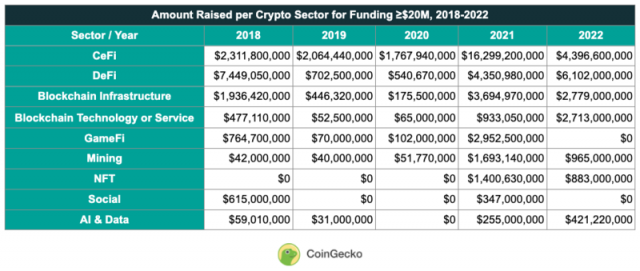
Expectations for airdrop season
As we move towards 2024, expectations are high in the world of crypto assets (virtual currencies) for the “airdrop season.”
In 2023, projects such as Arbitrum, Celestia, Pyth Network, and Jito gained attention and distributed token rewards to early users. In some projects, users were reported to be receiving rewards worth an average of $10,000.
Airdrops are said to be used as a strategy to attract new users to the ecosystem, while also providing a return to venture capital (VC) investors who have invested in the project.
Chico, a researcher at the Brazilian research organization Paradigma Education, told the virtual currency media CryptoBriefing that the time will come for VCs to collect funds through airdrops in 2024.
The main reason for this is that in 2022, the amount invested in virtual currency startups by VCs reached $22.1 billion (a record high).
Given that token allocations to VCs typically go through a vesting period of one year after issuance, it is reasonable to expect the project to issue tokens in 2024. Given the bull market that will last until 2025, VCs will have an opportunity to sell their tokens during this period. Large-scale airdrops are expected, including LayerZero, EigenLayer, and zkSync.

Source: CoinGecko
According to CoinGecko statistics, in 2022, the amount of funding raised by crypto startups for decentralized finance projects reached $2.71 billion, an increase of 190% compared to the previous year. This is nearly triple the $930 million raised in 2021 and more than 41 times the $65 million raised in 2020, at the height of the DeFi boom.
connection:Cryptocurrency startup funding to drop 68% year-on-year in 2023
Purpose of airdrop
Airdrops are primarily used to decentralize tokens and attract users to engage with governance proposals. According to Chico, various opportunities are expected, including Ethereum’s Layer 2 blockchain, the Cosmos ecosystem, and dApps on Solana.
However, the distribution of tokens to the community is limited. As the number of airdrop targets increases, the amount of tokens distributed per person decreases, and the benefits received by individual users tend to be diluted.
Additionally, the hurdles for beginners and general users to receive airdrops are rising. Receiving an airdrop typically requires a transaction history on the blockchain, but airdrop eligibility requirements are becoming increasingly complex, with continuity and More and more projects are establishing specific monetary thresholds.
Additionally, smart contract fraud is rampant, and caution is advised as there is a risk of losing funds by signing a careless contract. Matheus Guelfi, co-founder of Brazilian research team Modular Crypto, pointed out that “each project requires individual evaluation, and not every airdrop will bring big rewards.”
connection:How to use the virtual currency wallet “MetaMask” that even beginners can understand
Risk management is important for air drone hunting
Additionally, Consensys, which owns the developer of crypto wallet Metamask, recommends assessing the risks before granting token access to dApps.
Key checks include the reputation of the project, how long it has been in operation, the existence of legitimate community channels, developer transparency, whether the smart contract has been audited, and checking the contract address on a block explorer.
Furthermore, when using a DEX, you can use the “Custom Spend Limit” field to set limits on access rights, and Metamask can manage access authorization based on the amount of tokens to avoid unnecessary risks.
connection:Web3 Wallet Metamask Explanation of precautions when using
The post Is it the beginning of the airdrop season in 2024? VC investment trends indicate signs of a rush to issue tokens appeared first on Our Bitcoin News.

 1 year ago
108
1 year ago
108














 English (US) ·
English (US) ·